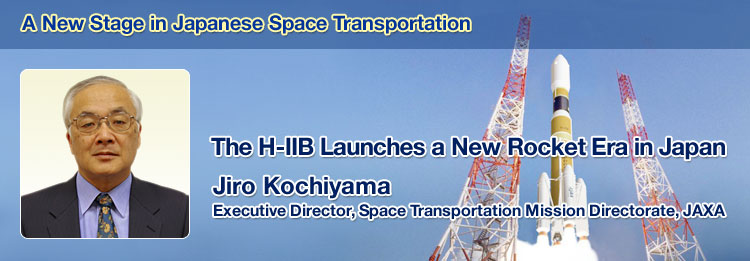
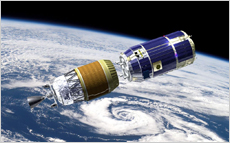
The HTV separated from the H-IIB Launch Vehicle's second stage. (Artist's Concept)
Major space transportation systems based on the H-IIA and H-IIB launch vehicles were designated as Key Technologies of National Importance under the Third Science and Technology Basic Plan, adopted in 2006.
The main role of these domestically produced large-scale launch vehicles is to secure Japan's ability to independently launch payloads, such as satellites, equipment and supplies, to space. Now, it is important for us to maintain reliable launch vehicles and be prepared for launch at any time.
The development of large-scale launch vehicles such as the H-IIA and the H-IIB is essential to ensure Japan's international competitiveness. They not only enable us to carry out national missions such as the launch of earth observation or navigation satellites and the transportation of supplies to the International Space Station (ISS) by the H-II Transfer Vehicle (HTV), but also allow us to launch the multiple satellites simultaneously. We would like to contribute to the lives of citizens by using these launch vehicles to deploy these necessary satellites in space. Another future objective is to create new industries in Japan and stimulate domestic industries by developing reliable and cost-efficient launch vehicles for the international satellite launch market.
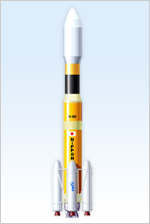
H-IIB Launch Vehicle
The second contribution is the transfer of advanced technology for daily life from the development of rockets used in the extreme conditions of space. Examples include insulating material developed for rockets that can be used in housing construction, and design of high-speed railway trains based on rocket aerodynamics.
The third benefit to Japanese society from the development of launch vehicles is the economic effect. If Japanese launch vehicles can transport commercial satellites and we can export our rocket technology, a new industry will be generated in Japan that will create jobs in many fields. These economic activities can contribute a great deal to the development of the nation. For this reason, we have transferred our rocket technology and launch operations to the private sector, and are trying to expand our space industry by improving the environment in which we can accept international orders for satellite launches.
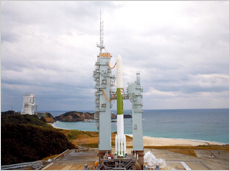
The H-I Launch Vehicle (1986-1992)
Japanese rocket technology has moved out of the research and development phase and is now maturing as an industry by continually accumulating technologies. "Maturing" technology means enhancing our reliability to the ultimate level through research and development. Such mature technology can be fundamental to Japanese space transportation systems in the future.
Globally, we can say the level of Japanese rockets today is close to the highest standard in the world, but the difference is that we have less launch experience. Currently, our total launch count is seven with the N-I rocket, eight with the N-II, nine with the H-I, seven with the H-II and 14 with the H-IIA. Throughout the world, there are many launch vehicles that have recorded more than 100 launches, and some have had 150 consecutive successful launches. In this sense, I think that frequently and successfully launching the H-IIA will lead to the maturing of Japanese rocket development.
In the future, we would like to mature the development of large-scale launch vehicles such as the H-IIA and the H-IIB, and build up the power of the Japanese space industry. We would also like to form and develop technology for reusable space transportation and the fundamentals of manned space technology.
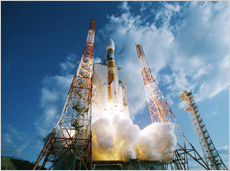
Launch of the H-IIA Launch Vehicle
At one time, Japanese rockets experienced consecutive failures, and we not only investigated the direct causes of the failures and took countermeasures, but also carried out extensive studies to identify fundamental problems in the development process. Through these intensive analyses, we are steadily improving our reliability. The result has been our achievement of eight straight successful launches of the H-IIA Launch Vehicle. Overall, we have secured an almost 93 percent success rate.
Although the launches were successful, there still were some minor problems with each launch. We have assessed and dealt with all of these troubles appropriately. These measures have further boosted our reliability, and as a result we can now finally transfer rocket launch operations to the private sector. Reliability is the most important factor in the industrialization and commercialization of rockets. If the rocket lacks reliability, we cannot use it for space travel in the future. Even after operations are privatized, JAXA will continue its efforts to improve the reliability of its rockets.
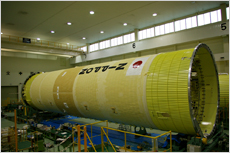
H-IIB Launch Vehicle under manufacture (MHI Tobishima factory)
One goal of the joint public-private development of the H-IIB Launch Vehicle is the improved efficiency brought by the private sector's management skills, as we asked the private sector to lead the development. The H-IIB Launch Vehicle development project has a small budget, which is rather common in Japan, so it is particularly important that we maintain our maximum efficiency. For that, both the public and private sectors are working very hard.
Another purpose is to smoothly transfer the technology after completing development. As we have done in the aircraft industry, we plan to transfer publicly developed space transportation technology to the private sector.
The Japanese space industry has reached a new era with the privatization of launch operations of the H-IIA Launch Vehicle and the joint public-private development of the H-IIB Launch Vehicle.
At present, the Japanese economy is led primarily by the automobile and electronics industries, but I hope the aerospace industry will become a major part of the Japanese economy in the future. To achieve this goal, we will let the private sector do what it does best, and JAXA will concentrate on the research and development of advanced technologies. I also expect the companies that receive our technologies to promote themselves in the international market in order to boost the Japanese economy. JAXA would like to play an "unsung hero" role to help develop the Japanese economy, industry and scientific technology.
Related Link: Space Transportation Mission Directorate
Jiro Kochiyama
Executive Director, Space Transportation Mission Directorate, JAXA
Mr. Kochiyama graduated from the Department of Mechanical Engineering, Faculty of Science and Engineering, Waseda University, in 1970, and joined NASDA (now part of JAXA) in the same year. In 1998, Mr. Kochiyama became a project manager for the H-II Orbiting Plane-Experimental (HOPE-X), and in 2003, for the H-IIA Launch Vehicle. In 2005, he was appointed Director of the Office of Space Flight and Operations. He has been in his current post since 2006.
Executive Director, Space Transportation Mission Directorate, JAXA
Mr. Kochiyama graduated from the Department of Mechanical Engineering, Faculty of Science and Engineering, Waseda University, in 1970, and joined NASDA (now part of JAXA) in the same year. In 1998, Mr. Kochiyama became a project manager for the H-II Orbiting Plane-Experimental (HOPE-X), and in 2003, for the H-IIA Launch Vehicle. In 2005, he was appointed Director of the Office of Space Flight and Operations. He has been in his current post since 2006.
The H-IIB Launches a New Rocket Era in Japan
H-IIB Launch Vehicle: Designed for World-Class Launch Capability
The Next Step in Japan's Space Development
HTV: An Indispensable Part of ISS Operations
H-IIB Launch Vehicle: Designed for World-Class Launch Capability
The Next Step in Japan's Space Development
HTV: An Indispensable Part of ISS Operations